Ssamziegil brings spark to Insa-dong streets
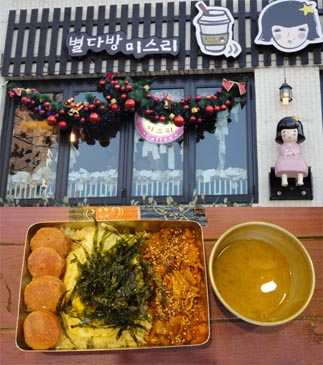
Miss Lee Cafe
Ssamziegil’s identity stems from Ssamzie Co. Ltd., the company that opened the complex to support young, talented Korean artists. Although Ssamziegil declared bankruptcy this year and was bought by Eunsan Group, Ssamzie Co. paved the way for Korea’s subculture through various cultural programs on top of its main fashion business.
One of the main projects that Ssamzie created is the annual Ssamzie Sound Festival, now in its 11th year, which brings together local indie musicians to perform.
Ssamziegil carries on the spirit of the music festival by giving selected up-and-coming designers space to open shops within the complex.
“We can’t dwell on the past. We have to hold on to the traditional values while following the current flow in the art industry,” said Jung Jae-ho, vice president of Eunsan Group, which now owns Ssamziegil. “We want Ssamziegil to continue to be a bridge between the past and present. To do that, we have to support new artists.”
The restaurants and shops in the alleyways around Ssamziegil cater to this alternative, youthful spirit yet add their own individual touches.
Two establishments that bridge the neighborhood’s traditional and modern elements are Caring Ms. Hyun-ja and Miss Lee Cafe, which are both located near the complex.
Stepping into Caring Ms. Hyun-ja is like traveling back in time to 1960s or 1970s Korea. The restaurant, complete with vintage fonts on the menu and period furniture, serves popular Korean dishes like kimchi stew and potato pancakes in a retro-chic atmosphere.
Miss Lee Cafe, which is down the street from Caring Ms. Hyun-ja, echoes the cafe’s retro vibe in its decor, which is punctuated with kitschy, vintage furniture, a Bruce Lee poster and a paper map for Korean dice games that used to be popular with children in the 1980s.
“The restaurant has things that I haven’t seen in years, like the Wonder Woman poster,” said Bu Si, a trading company employer who was dining there.
For those looking to experience traditional Korean cuisine, the area near Ssamziegil is also home to restaurants that serve classic dishes including temple food.
One of these is Sanchon, which has been making Korean temple food for visitors for the past 13 years. The restaurant’s set menus are served with namul (assorted seasoned vegetables) and japchae (a mixture of glass noodles, vegetables and sliced beef or pork), which are essential to temple cuisine.
“What shocked me was the flavoring of each of the namul dishes, which all looked the same but had different colors and textures,” said Heather Spence, a tourist from England visiting the neighborhood.
Restaurant Yeojaman, another establishment near Ssamziegil, offers a dish that is rare in Seoul. Its signature dish of kkomak (clams), cooked South Jeolla-style, draws numerous customers to the restaurant every day. Yeojaman is the name of a gulf in South Jeolla.
The restaurant’s owner, Lee Mi-rye, was a film director in the 1980s. She said that back then she had many business meetings in Seoul but couldn’t find the right place to meet clients because she was unimpressed with the food. That inspired her to open Yeojaman.
Restaurants in the area near Ssamziegil also specialize in other traditional Korean foods, including the now globally popular bibimbap, or rice with mixed vegetables. Gogung, another restaurant in the neighborhood, cooks the dish in the traditional way. Its main branch is located in Jeonju, North Jeolla, which is famous for Jeonju bibimbap.
“Customers can ask and learn about the history of bibimbap from our employees because they have all been trained to know the information,” said Nam Sun-mi, the manager of Gogung in Insa-dong. “This allows customers to learn about the culture of bibimbap while enjoying the dish.”
Reflecting the mixture of tradition and modernity that coexist in the area, the alleys near Ssamziegil also contain two fusion Italian restaurants.
The Italian restaurant Ahndamiro, housed in a four-story wooden building, has been in the area for six years.
“Many people ask why we decided to open in Insa-dong instead of in places like Gangnam or Apgujeong [where there is a larger market for Italian cuisine] but we feel special in Insa-dong,” said Teddy Kim, the manager.
Farther down from Ahndamiro is Apple Tree, whose exterior looks like a residential home. Inside, however, the place is an Italian pub with a cocktail bar in the back, three kegs of draft beer in the corners, and a rack of wine bottles on the wall. Here, the definition of fusion takes on a whole new meaning. The dishes are based on Korean cuisine, but with a Western twist. Its chicken dalbap, or cooked chicken wings, is served with apple sauce and potatoes.
The area in the vicinity of Ssamziegil often plays host to a variety of street performances.
But none is quite like the one at Kkul Tare, where young men in chef outfits make kkul tare, a traditional Korean court cake, in an improvised performance for the crowds of visitors who gather in front of the shop. They turn white dough into silky strands of candy-like cake while entertaining audiences with a song - sung alternately in Korean, Japanese and English - that tells the history of the cake and how it’s made.
The lively spirit of Ssamziegil and the restaurants around it has not only infused the streets and alleyways with a mixture of traditional and modern values, it has also inspired local residents to take a new interest in the area.
“Only in Insa-dong can you see unique venues like Miss Lee Cafe, where you can eat a lunch that comes in a metal lunchbox circa 1960s Korea,” said Kim So-yeon, an employee at City Hall, who was visiting the neighborhood.
Miss Lee Cafe
This cafe has the feel of a coffee house from the 1960s and 1970s. The menu is also a tribute to that time with a lunch special that is served in a traditional metal lunchbox like the ones children used to carry to school. The lunchbox comes with rice, a fried egg, sausages and fried kimchee sprinkled with roasted seaweed and sesame seeds.
The lunch box is 5,000 won.
Hours are Monday to Sunday 10 a.m. to 11p.m.
Gwanhun-dong Jongno-gu 144-2nd floor
(02)739-0939, www.missleecafe.com
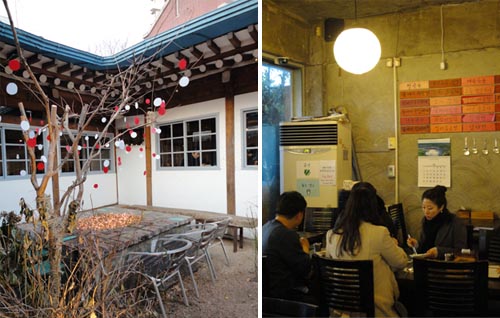
Apple Tree / Caring Ms. Hyun-ja
Apple Tree
Apple Tree is an Italian-Korean fusion restaurant whose most popular menu item is dalbap (cooked chicken wings with apple sauce and potatoes).
But the main attraction here is the courtyard, which has wooden tables and two bare trees, now decorated with a string of paper apples.
Prices range from 6,500 won to 23,000 won. Hours are Monday to Saturday 11:30 a.m. to 11:30 p.m. and Sunday 11:30 a.m. to 11 p.m.
Gwanhun-dong Jongro-gu 84-5
(02)722-5051
Caring Ms. Hyun-ja
A handwritten menu and hwatu (go) cards numbering the tables decorate this restaurant, where the specialty is grilled mackerel.
Set menus are priced at 45,000 won, a la carte items range from 5,000 won to 20,000 won. Hours are 11 a.m. to 9 p.m.
Gwanhun-dong Jongno-gu 110-330
(02)725-7360
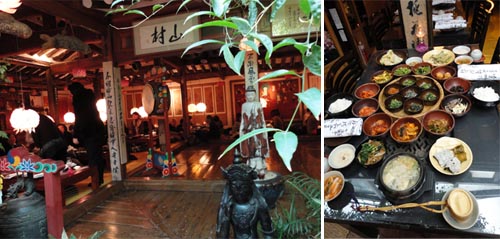
Sanchon
Sanchon
Sanchon is located down a narrow alleyway in Insa-dong, but don’t let that scare you away. The Korean temple cuisine featured is delicious. There is a performance of traditional Korean dance during dinner at 8 p.m.
The lunch set is 22,000 won, and the dinner set is 39,000 won.
Hours are 12 p.m. to 9:30 p.m. Monday to Sunday.
Gwanhun-dong Jongno District 14
(02) 735-0312, www.sanchon.com
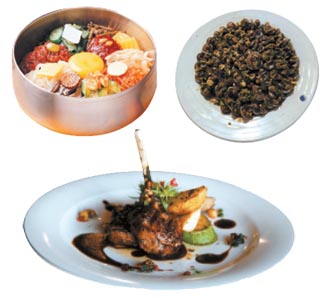
Gogung / Yeojaman /Ahndamiro
Gogung
This restaurant makes its specialty known with an oversized bowl of bibimbap (mixed rice) placed right in front of the entrance. The menu features seven different types of bibimbap, including Jeonju bibimbap, its most famous.
Bibimbap is priced at 8,000 won to 15,000 won.
Hours are 10:30 a.m. to 9 p.m. Monday to Sunday.
Gwanhun-dong Jongno District 38
(02) 736-3211, www.gogung.co.kr
Yeojaman
This restaurant is legendary for its South Jeolla-style kkomak (clams) and other dishes from the region that are hard to find in Seoul. Owner and film director Lee Mi-rae (of 1991’s “This is the Beginning of Love”) opened the restaurant as a space for meetings and also to showcase South Jeolla cuisine.
The restaurant’s name means “women only” in Korean, but is also the name of a gulf in South Jeolla.
Prices range from 7,000 won to 30,000 won.
Hours are 10 a.m. to 11:30 p.m. Monday to Sunday.
Gwanhun-dong Jongno District 1-1
(02) 725-9829
Ahndamiro
This restaurant shines with silver decorations and butterfly figurines scattered throughout. The third floor terrace is closed in the winter, but it’s a good spot for people-watching in the warmer months. The fusion menu includes shrimp and spinach linguine and grilled lamb ribs with rosemary sauce.
Lunch prices range from 32,500 won to 58,500 won; dinner prices range from 37,500 won to 50,000 won.
Hours are 11:30 a.m. to 12:00 a.m. Monday to Sunday. Gwanhun-dong Jongno District 15-2
(02) 730-5777, www.ahndamiro.com
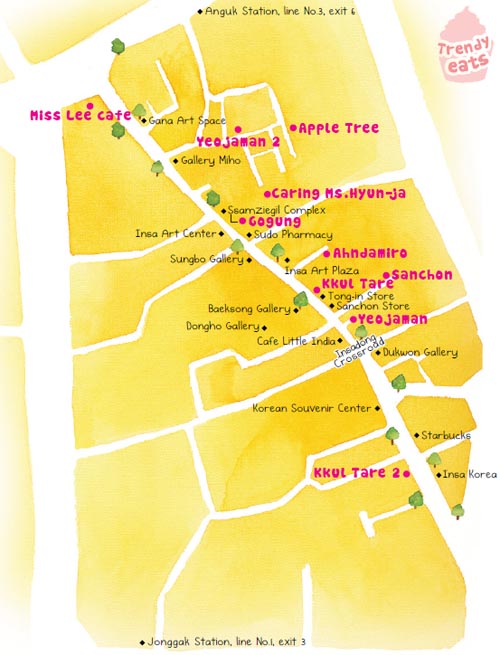
Illustration by Park Jae-won
By Junghee Lee [estyle@joongang.co.kr]










with the Korea JoongAng Daily
To write comments, please log in to one of the accounts.
Standards Board Policy (0/250자)